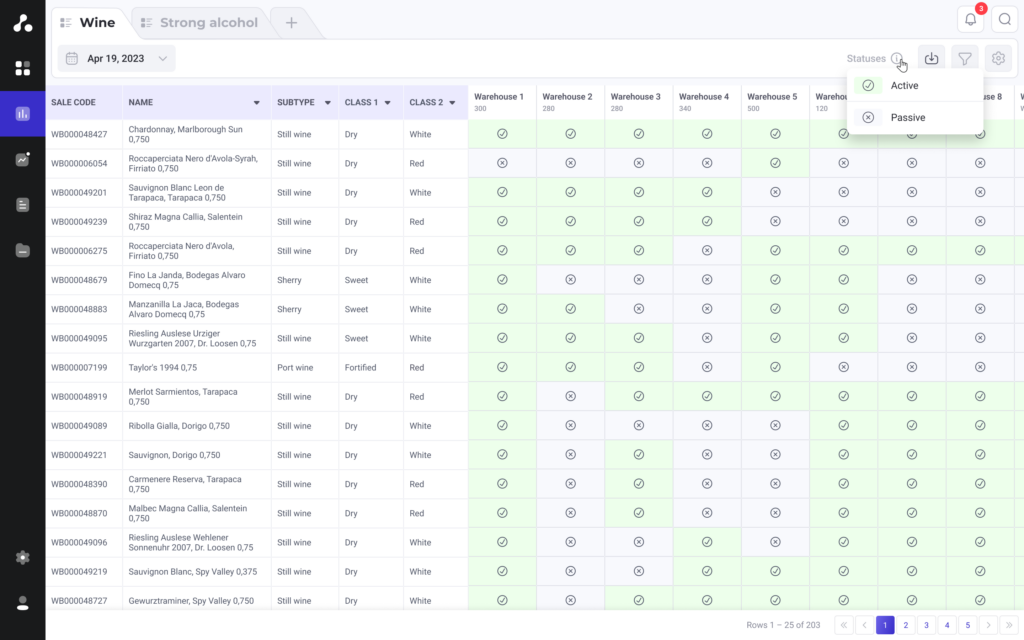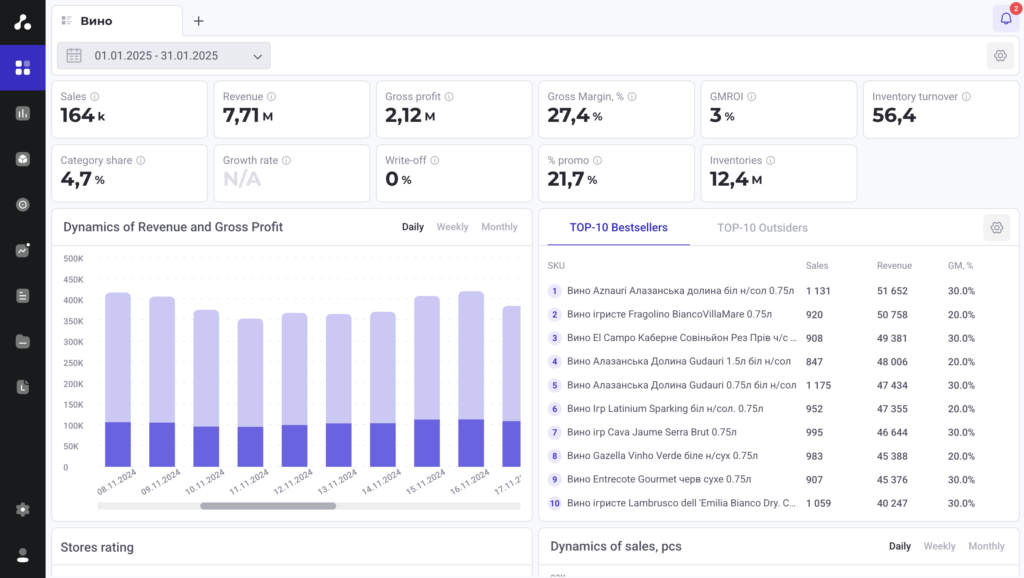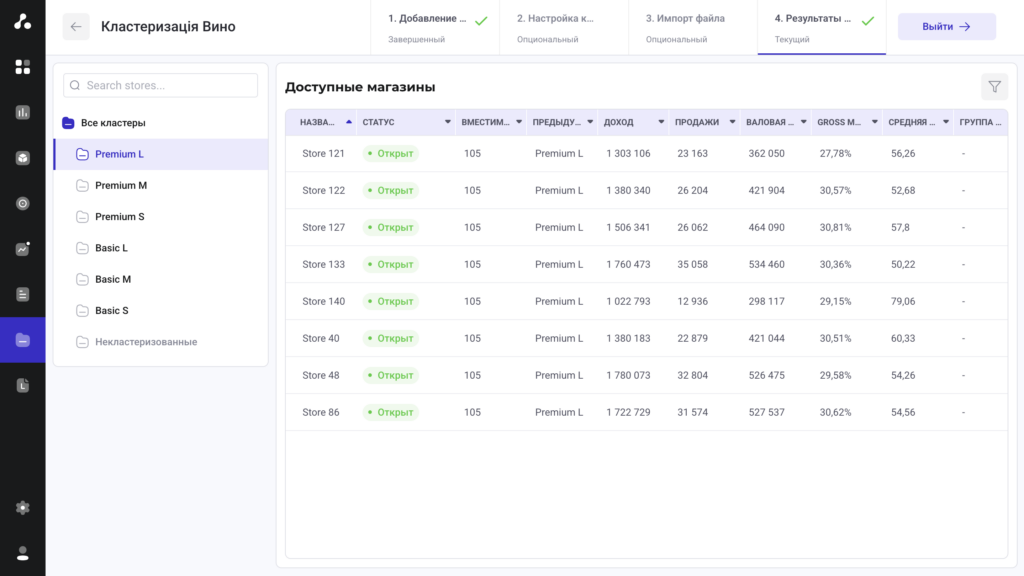Assortment Matrix: Fundamentals of Structuring and Analysis

What Is an Assortment Matrix and Why It Matters
An assortment matrix is a structured table that displays all the products offered in a store, category, or retail chain. It shows which items by category are included in the current assortment, what role they play, and how their presence aligns with the store format and overall business strategy.
Definition of an Assortment (Product) Matrix
Simply put, the assortment matrix is a tool for systematically managing what is sold at a retail location — and why.
The matrix can be basic — listing products with key attributes — or advanced, incorporating profitability data, sales performance, store formats, customer preferences, and other essential parameters.
Why Retailers Create an Assortment Matrix
Building an assortment matrix is a core part of retail management. It helps to:
- Align the assortment with the store format and target audience needs
- Define the optimal product structure and shelf layout
- Prevent random additions of new SKUs and overexpansion of the matrix
- Simplify purchasing planning and inventory management
- Lay the foundation for pricing strategies, promotional activities, and planograms
In a highly competitive and volatile market, the assortment matrix enables rapid adaptation and data-driven decision-making.
Learn more about our assortment management system.
Key Functions of the Assortment Matrix
A well-designed product assortment matrix allows retailers to:
- Plan and optimize the assortment based on region, format, and segment
- Identify best-selling (driver) products and low-performing (dead weight) items
- Streamline procurement and organize supplier relationships
- Eliminate duplicate items and control the number of SKUs per category
- Monitor product lifecycle and make timely decisions about product introduction or delisting
- Standardize assortment management practices across the retail chain
Thus, the assortment matrix is not just a product list — it’s a strategic tool for category managers, marketers, buyers, and business leaders.
Core Groups and Types of Items in the Assortment Matrix
While the matrix may vary in format, its core structure classifies products by function, role, and impact on sales. This helps to build a balanced assortment that meets both business goals and customer expectations.
Below are the main product types typically included in a retail assortment matrix.
Core Product Group
Core products are the foundation of the assortment — essential items that meet basic customer needs. These are the products customers primarily come for, and they ensure a steady sales flow.
In a grocery store, for example, core products include bread, milk, grains, and meat.
Managing this group is critical to retaining customers and ensuring a minimum level of sales.
Complementary Products
Complementary products are not essential but are often purchased alongside core items. Including them in the assortment increases the average basket size and supports cross-selling.
Examples:
- Toothbrush placed next to toothpaste
- Disposable cups near beverages
- Sauce next to pasta
Strategic placement of complementary products based on planograms boosts impulse purchases.
Substitute Products
Substitute products are alternatives to core items, allowing customers to choose based on price, brand, ingredients, or packaging.
These products provide assortment flexibility and help to:
- Retain customers when their preferred item is out of stock
- Test new SKUs without fully replacing existing ones
- Adapt the assortment to shifting demand
Complementary Products
Complementary products are items purchased together due to functional interdependence. Unlike related items placed nearby for convenience, complementary products are linked by use.
Examples:
- Pet food + food bowl
- Coffee + French press
- Smartphone + phone case
Building the matrix with these connections in mind can increase sales and boost customer loyalty.
High-Demand and Premium Products
High-demand products are fast-moving items with stable demand. They drive traffic and are essential for attracting and retaining customers.
Premium (status) products help shape the store’s image and increase average transaction value. While they may generate lower margins, their value for positioning and brand perception is significant.
Key Principles of Assortment Matrix Planning
A well-structured assortment matrix goes beyond product listings and internal category hierarchies. It incorporates strategic factors such as customer behavior, store location, and logistics. Below are the key principles for building an effective, profitable assortment strategy.
Customer-Centric Approach
The primary principle is aligning the matrix with the needs of the target audience. Every SKU should serve a clear function: meet demand, complement the category, or enhance customer loyalty.
This is supported by:
- Analyzing consumer preferences
- Monitoring seasonal demand
- Regularly adjusting the assortment based on sales data
Example: If data shows high demand for gluten-free products in a specific area, those SKUs should be included in the grocery assortment matrix.
Store Format and Location
Store type and geographic location have a direct impact on product selection and depth.
- Neighborhood stores prioritize essential goods
- Discount stores focus on low prices and high turnover
- Supermarkets and premium outlets include branded and premium items
That’s why assortment planning must account for local conditions and traffic specifics when developing the matrix for a store or category.
Logistics and Supply Chain Considerations
Key logistical factors to account for when building the matrix include:
- Delivery frequency and supply reliability
- Storage capacity
- Shelf life of products
Items with short life cycles or high handling costs may not be suitable for permanent inclusion in the assortment.
Example: Refrigerated desserts in a small store without cooling equipment represent a logistical risk and potential losses.
Product Life Cycle Management
Product life cycle is a critical factor in assortment management. During the growth stage, items require active promotion and matrix presence. During decline, they should be reviewed and potentially delisted.
Regular matrix updates ensure responsiveness to life cycle shifts and support performance optimization.
Balancing Assortment Breadth and Depth
An effective matrix maintains a healthy balance between:
- Breadth (number of product categories)
- Depth (number of SKUs per category)
An overly broad assortment complicates management and increases costs, while a narrow one may reduce store appeal.
The category manager’s goal is to strike the right balance between assortment completeness and operational efficiency.
Stages of Building an Assortment Matrix
Creating an assortment matrix is not a one-time task — it’s a step-by-step strategic process. The effectiveness of the matrix, its relevance to customer needs, and its impact on business outcomes all depend on the quality of each stage.
1. Data Collection and Market Analysis
The first step is to conduct a comprehensive analysis of both internal and external environments. This includes gathering data on sales, turnover, seasonality, inventory levels, as well as studying market trends, competitor behavior, regional demand, and customer preferences. A strong analytical foundation helps ensure objective decision-making and reduces the risk of subjective errors.
2. Defining Business Format and Target Audience
The type of retail outlet — its size, format (e.g., discount store, supermarket, premium store) — and customer profile determine the appropriate product mix. A convenience store, for instance, requires a vastly different assortment than a hypermarket.
3. Product Categorization
At this stage, products are grouped into categories and subcategories based on their purpose, consumer properties, demand, and price segment. This step is critical for building a clear, manageable assortment structure.
4. Pricing Strategy Development
Assortment planning is directly linked to pricing. You must define price tiers within each category — entry-level, mid-range, and premium — to guide consumer choices, ensure profitability, and maintain competitiveness.
5. Assortment Balancing
Here, you evaluate the breadth (number of categories) and depth (number of SKUs per category). The goal is to strike a balance between variety and manageability. A narrow assortment may fail to meet demand, while an overly broad one can lead to excess inventory and operational complexity.
6. Matrix Construction
After analysis, categorization, and strategic planning, a table is created that defines which products, in what volume, and for which store (or cluster) should be available. This serves as the foundation for procurement, planograms, merchandising, and category management.
7. Ongoing Analysis and Adjustment
Even a perfectly built matrix must be reviewed regularly. Performance indicators such as turnover, revenue impact, and customer feedback should be monitored. Based on the analysis, non-performing SKUs should be removed, replaced, rotated, or new items introduced.
Common Mistakes in Assortment Matrix Planning
Mistakes made during the matrix development phase can seriously impact business profitability, category management efficiency, and customer satisfaction. Below are some of the most common errors.
Lack of Data-Driven Analysis
Relying on intuition rather than analytics is one of the biggest pitfalls. Without reliable data on sales, customer behavior, and competitive dynamics, it’s difficult to distinguish between products that actually generate demand and those that simply occupy shelf space.
Overextending the Assortment
Attempting to cover too many product lines leads to reduced turnover, higher storage and logistics costs, and management complexity. The result is lower category profitability and an increased risk of unsellable inventory.
Excessively Narrow Assortment
On the flip side, a too-limited selection reduces store appeal and drives customers away — especially when competitors offer more options. If a customer can’t find the product they need, they’ll go elsewhere.
Poor Segmentation
Misclassifying products or grouping them ineffectively makes assortment management harder. This may cause issues like redundant SKUs, missing complementary products, and gaps in key price segments.
Lack of Ongoing Monitoring
Even the most robust assortment matrix loses relevance without regular review. Failing to track sales dynamics, seasonality, and new product trends leads to missed opportunities and eroded profitability.
How to Analyze and Adjust the Assortment Matrix
To maintain its effectiveness, the assortment matrix must be regularly analyzed and updated. This ensures adaptability to changes in demand, seasonality, and consumer behavior, as well as improved category performance.
Review Frequency
The optimal review frequency depends on store format, product group, and sales dynamics. As a general guideline:
- For food products — monthly or quarterly
- For seasonal categories — before each season
- For high-turnover groups — more frequently than for slow-moving categories
It’s important to define a clear update schedule and assign responsible staff in your internal regulations.
Key Metrics for Assortment Performance Evaluation
To assess the matrix’s performance, use the following methods and indicators:
- Turnover and gross margin per category and SKU
- Share of each SKU in total revenue
- Turnover rate and average shelf share
- ABC-XYZ analysis (to segment SKUs by value and demand stability)
- Benchmarking against similar stores or clusters
The analysis should be conducted by category as well as by individual store, cluster, or retail format.
Using IT Systems to Manage the Assortment Matrix
Modern automation tools such as ABM Assortment allow you to not only structure and consolidate data in real time but also to:
- Monitor key performance metrics continuously
- Receive optimization recommendations (e.g., SKU additions/removals)
- Automate matrix adjustments at the category, store, or cluster level
- Reduce workload on category managers and minimize human error
Such solutions significantly accelerate decision-making and enable data-driven assortment management.
Automating Assortment Matrix Management with ABM Cloud
Effective assortment management in retail is impossible without automation. ABM Assortment is a digital platform that brings together analytics, planning, category control, and inventory tracking in one workspace. It simplifies daily operations for category managers and brings transparency to decision-making. Here’s how it works in practice:
Interactive Assortment Matrix

At the heart of the system is an interactive product matrix that enables managers to oversee SKUs by store, cluster, or category. It takes into account real-time sales, turnover, and SKU status, and provides recommendations for adding or removing products. Integration with accounting systems ensures that the data is always up to date.
Dashboard and Analytics

The dashboard provides visibility into key metrics: sales, revenue, gross margin, seasonality, and trends. Customizable reports and insights support data-driven decisions. Visual performance rankings by store and category help identify growth opportunities.
Cluster-Based Planning

Automatic clustering of stores by parameters such as format, size, average basket, and region enables assortment strategies tailored to each store type. This is especially important for chains with wide geographic coverage and varied consumer behavior.
BI Module and Reports

The built-in business intelligence module offers:
- Supplier mapping
- Inventory analysis
- SKU and category reports
- Daily and weekly performance reports
- Plan vs. actual comparisons
These tools provide deep insights into category behavior and purchasing efficiency.
Strategic Planning
ABM Assortment допомагає будувати цифрові стратегії розвитку категорій на основі фактів, трендів і сезонності. Система підказує, де потрібно коригувати підхід — від глибини асортименту до пріоритетів категорій.
Warehouse Coordination
The warehouse matrix module synchronizes product statuses between stores and distribution centers, streamlining inventory flows and reducing manual work..
Conclusion
ABM Assortment transforms the assortment matrix from a static table into a dynamic decision-making tool. With the power of automation and analytics, you gain:
- Accurate control over product assortment
- Reduced operational costs
- Improved category profitability
- Fewer errors and losses
Top Questions
Assortment Matrix — Simple Definition
An assortment matrix is a structured table that displays all products offered in a store or retail chain, grouped by categories and sales points. It helps you understand what is sold, where, and how it impacts overall results. In simple terms, it’s a product map of your retail business.
How to Build an Effective Assortment Matrix
To create a functional assortment matrix, follow these key steps:
-
Analyze your target audience and competitive environment
-
Define your store format and product categories
-
Develop your pricing strategy and consider logistics
-
Balance the breadth and depth of your assortment
-
Continuously review and adjust the matrix based on sales data
Using tools like ABM Assortment simplifies the process, saves time on analytics, and improves decision accuracy.
How Often Should You Update the Product Matrix?
Ideally — quarterly. However, in fast-moving categories like food and seasonal items, monthly reviews may be necessary. The update frequency depends on sales volume, product life cycles, and assortment complexity. It’s crucial to make decisions based on actual data, not assumptions.
Common Mistakes in Assortment Matrix Planning
Typical mistakes include:
-
Lack of detailed demand and consumer behavior analysis
-
Excessively broad or narrow product range
-
Ignoring seasonality and product life cycles
-
Poor segmentation and no store-level clustering
-
Manual assortment planning without analytics or IT support
These issues lead to slow-moving stock, profit loss, and reduced turnover.



